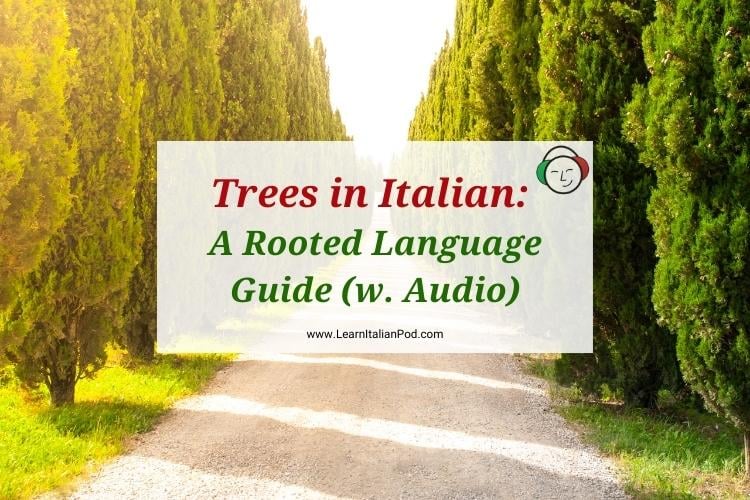Trees in Italian: A Rooted Language Guide (w. Audio)
Ready to embark on a journey to learn about trees in Italian and expand your Italian dictionary? You’re in the right place!
Born and bred in Italy and an expert in language teaching, I’m here to guide you through this adventure.
Now, let’s dive into our Italian tree vocabulary. The words have been thoughtfully organized into four distinct sections:
- General Tree-Related Italian Terms
- Common Trees in Italian
- Special or Unique Trees in Italian
- Alternative Meanings of Albero (Tree)
This layout is designed to ensure a seamless learning progression, from foundational terminology through common and unique tree species and finally to the diverse meanings of the word “albero” (tree in Italian).
So, ready to immerse in the verdant world of Italian words for trees? Let’s get started, beginning with the basics.
What is the Italian Word for Tree?

The Italian for tree is “albero.” Listen to the pronunciation below to learn how to say tree in Italian.
General Tree-Related Italian Terms
This section includes general terms related to trees that can apply to all types of trees. These are foundational terms that anyone learning about trees in Italian should know.
| Italian | English |
|---|---|
| L’albero | The tree |
| La pianta | The plant |
| Il ramo | The branch |
| La radice | The root |
| La corteccia | The bark |
| Il tronco | The trunk |
| Il petalo | The petal |
| Lo stelo | The stalk |
| Il gambo | The stem |
| Il seme | The seed |
Practicing with Tree-Related Italian Terms
Ready for a twist? Here’s a jam-packed example sentence loaded with our tree-related terms, serving as a mini forest for your language practice!
Example in Italian:
L’albero ha una corteccia rugosa, un tronco forte, rami che si estendono come braccia, e le radici ben ancorate nel terreno, da cui pendono gambo e petalo, pronti a dar vita a un nuovo seme.
English Translation:
The tree has a rough bark, a strong trunk, branches that extend like arms, and roots well anchored in the ground, from which hang stem and petal, ready to give life to a new seed.
Common Trees in Italian

This section covers Italian tree names that are more common or familiar, which may be the ones that people encounter in their daily lives or are native to Italy and other parts of Europe.
| Italian | English |
|---|---|
| L’abete | The fir |
| L’acero | The maple |
| La betulla | The birch |
| Il castagno | The chestnut tree |
| Il ciliegio | The cherry tree |
| Il cipresso | The cypress |
| Il faggio | The beech |
| Il fico | The fig tree |
| Il frassino | The ash |
| Il larice | The larch |
| Il pioppo | The poplar |
| Il pino | The pine |
| Il platano | The plane tree |
| La quercia | The oak |
| Il salice | The willow |
| L’olmo | The elm |
| L’ulivo | The olive tree |
Suggested Reading: Discover 135 basic Italian phrases for travel and download our convenient PDF cheat sheet for on-the-go reference.
A Thrilling Journey: Italian Tree Names in One Sentence
Get ready to explore how many of our tree names we can squeeze into one Italian sentence. Buckle up. This will be a thrilling journey through the forest with trees in Italian pronunciation at the forefront!
Example in Italian
Passeggiando nel bosco, ho ammirato l’abete alto, l’acero colorato, la betulla slanciata, il castagno robusto, il ciliegio in fiore, il cipresso solitario, il faggio ombroso, il fico carico di frutti, il frassino danzante, il larice maestoso, il pioppo che sussurrava al vento, il pino pungente, il platano ampio, la quercia antica, il salice piangente, l’olmo resistente e, in lontananza, ho intravisto un ulivo, simbolo della pace.
English Translation
Walking in the woods, I admired the tall fir, the colorful maple, the slender birch, the sturdy chestnut, the blooming cherry tree, the solitary cypress, the shady beech, the fig tree laden with fruit, the dancing ash, the majestic larch, the poplar whispering in the wind, the prickly pine, the wide plane tree, the ancient oak, the weeping willow, the resilient elm, and in the distance, I glimpsed an olive tree, a symbol of peace.
Fruits Versus Fruit Trees in Italian: A Gender Twist

In Italian, you’ll often find an interesting linguistic pattern – the names of fruits and nuts are usually feminine nouns. At the same time, the corresponding trees are typically masculine. Isn’t that intriguing? Let’s have a look at some examples to make this concept clearer:
| Italian Tree | English Tree | Italian Fruit | English Fruit |
|---|---|---|---|
| Il ciliegio | The cherry tree | La ciliegia | The cherry |
| Il melo | The apple tree | La mela | The apple |
| Il pesco | The peach tree | La pesca | The peach |
| Il pero | The pear tree | La pera | The pear |
| Il mandorlo | The almond tree | La mandorla | The almond |
Recommended Reading: 32 Beautiful Famous Italian Gardens to Visit in Italy
Special or Unique Trees in Italian

Venturing further into our arboreal journey, we encounter a collection of unique tree names. What makes these trees special? They’re not as commonly found in everyday Italian discourse or hold unique characteristics – they thrive in distinct climates, serve specific uses, or symbolize certain elements.
For instance, ‘L’alloro‘ (the laurel oak) is significant in Italian symbolism. This tree symbolizes victory and honor in Italy. Its leaves have been used since ancient times to crown the victors and the poets. This tradition still resonates in today’s graduation ceremonies.
In this section, we’ll learn about trees like the yew, the mulberry, the palm, and others that are linguistically interesting and rich with cultural and natural narratives. Let’s continue to branch out in our Italian tree knowledge.
| Italian | English |
|---|---|
| L’agrifoglio | The holly |
| L’alloro | The laurel oak |
| Il cedro | The cedar |
| Il gelso | The mulberry |
| La magnolia | The magnolia |
| La palma | The palm |
| La sequoia | The sequoia |
| Il sambuco | The elder |
| Il tasso | The yew |
| Il tiglio | The lime, tilia |
A New Voyage: Featuring Unique and Notable Italian Trees
Let’s continue our exploration with a new Italian sentence, this time featuring our unique and notable trees. Prepare for an enchanting voyage!
Example in Italian
Nel mio giardino incantato, l’agrifoglio brillava sotto il sole, l’alloro simboleggiava vittoria, il cedro diffondeva un profumo intenso, il gelso offriva dolci frutti, la magnolia mostrava i suoi fiori sontuosi, la palma proiettava ombre esotiche, la sequoia svettava verso il cielo, il sambuco portava grappoli di fiori bianchi, il tasso emanava un’aria misteriosa, e il tiglio, con le sue foglie vibranti, suscitava una sensazione di calma.
English Translation
In my enchanted garden, the holly sparkled under the sun, the laurel oak symbolized victory, the cedar spread a strong fragrance, the mulberry offered sweet fruits, the magnolia flaunted its sumptuous flowers, the palm projected exotic shadows, the sequoia towered towards the sky, the elder bore clusters of white flowers, the yew radiated an air of mystery, and the lime tree, with its vibrant leaves, elicited a sense of calm.
Alternative Meanings of the Italian Word “Albero”

While ‘albero’ is often translated to ‘tree’ in English, it’s worth noting that this Italian word can have other meanings as well, depending on the context. In nautical and mechanical terms, ‘albero‘ can refer to a ‘mast‘ or a ‘shaft.’ For example:
| Italian | English |
|---|---|
| Albero di mezzana | Mizzen mast |
| Albero di trasmissione | Gear shaft |
| Albero maestro / di maestra | Mainmast |
| Albero motore | Driveshaft |
| Albero di trinchetto | Foremast |
| Albero a gomiti | Crankshaft |
In addition, ‘albero‘ can also be used to describe anything with a branching structure similar to a tree. Here are some examples:
| Italian | English |
|---|---|
| Albero genealogico | Family tree |
| Diagramma ad albero | Tree diagram |
| Albero bronchiale | Bronchial tree |
This multi-faceted use of ‘albero’ exemplifies the rich and complex nature of the Italian language. Therefore, don’t be surprised if you encounter this word in diverse contexts when exploring Italy’s vibrant culture and way of life.
Frequently Asked Questions
How do you say tree in Italian?
The word for tree in Italian is “albero,” pronounced as “al-be-ro.”
Is tree masculine or feminine in Italian?
In Italian, the tree noun is “albero,” and it is masculine. So, you would say “l’albero” for “the tree.”
How do you say Christmas Tree in Italian?
The term for Christmas tree in Italian is “Albero di Natale.” It’s a heartwarming sight in homes across Italy during the festive season!
Suggested Reading: Christmas in Italy: discover the top 20 Italian Christmas destinations & best traditions.
What are the most popular types of trees in Italian?
The most popular types of trees you’ll find in Italy and Italian vocabulary include “l’ulivo” (olive tree), “il pino” (pine), “il cipresso” (cypress), and “la quercia” (oak).
What is the most famous tree in Italy?

One of the most iconic trees in Italy is undoubtedly the “ulivo,” or olive tree. It symbolizes the Mediterranean and is deeply tied to Italian culture, history, and cuisine.
Suggested Reading: Olive Oil from Spain vs Italy Guide: Which is Better?
Are there palm trees in Italy?
You can find palm trees in Italy, especially in coastal areas and Southern Italy. In Italian, the palm tree is “la palma.”
Final Thoughts
And there you have it! We’ve journeyed together through the lush world of Italian tree vocabulary, branching from the basic terms to the ordinary, unique, and metaphorical uses of ‘albero.’
I hope this linguistic excursion has enriched your English-Italian dictionary and planted a seed of fascination for how language intertwines with nature and culture.
So, keep nurturing your language skills; soon, you’ll be conversing as naturally as leaves rustling in the wind. Until our next adventure, arrivederci!
Before You Go…
Immerse yourself in luxury with our guide to the 20 Best Italian Fragrance Brands, where heritage meets modern allure.







